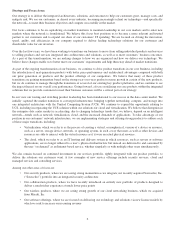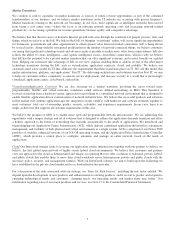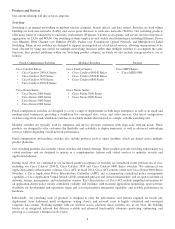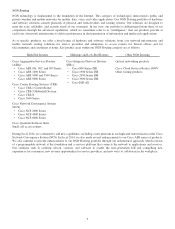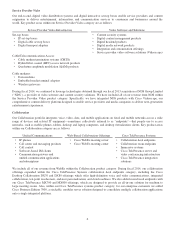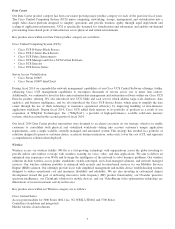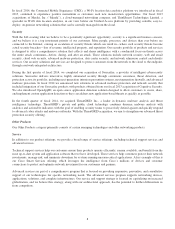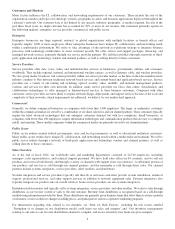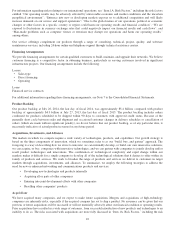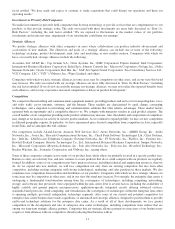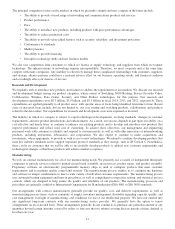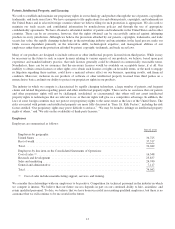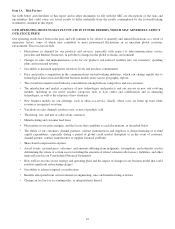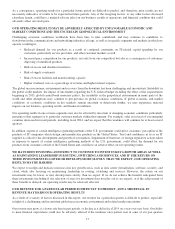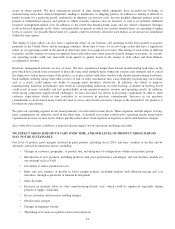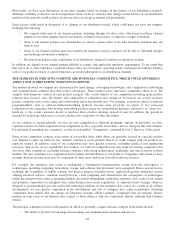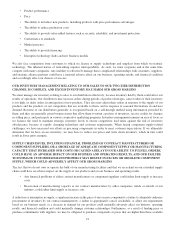Cisco 2014 Annual Report Download - page 19
Download and view the complete annual report
Please find page 19 of the 2014 Cisco annual report below. You can navigate through the pages in the report by either clicking on the pages listed below, or by using the keyword search tool below to find specific information within the annual report.factor entitled “We have made and expect to continue to make acquisitions that could disrupt our operations and harm our
operating results.”
Investments in Privately Held Companies
We make investments in privately held companies that develop technology or provide services that are complementary to our
products or that provide strategic value. The risks associated with these investments are more fully discussed in “Item 1A.
Risk Factors,” including the risk factor entitled “We are exposed to fluctuations in the market values of our portfolio
investments and in interest rates; impairment of our investments could harm our earnings.”
Strategic Alliances
We pursue strategic alliances with other companies in areas where collaboration can produce industry advancement and
acceleration of new markets. The objectives and goals of a strategic alliance can include one or more of the following:
technology exchange, product development, joint sales and marketing, or new market creation. Companies with which we
have, or recently had, strategic alliances include the following:
Accenture Ltd; AT&T Inc.; Cap Gemini S.A.; Citrix Systems, Inc.; EMC Corporation; Fujitsu Limited; Intel Corporation;
International Business Machines Corporation; Italtel SpA; Johnson Controls Inc.; Microsoft Corporation; NetApp, Inc.; Nokia
Siemens Networks; Oracle Corporation; Red Hat, Inc.; SAP AG; Sprint Nextel Corporation; Tata Consultancy Services Ltd.;
VCE Company, LLC (“VCE”); VMware, Inc.; Wipro Limited; and others.
Companies with which we have strategic alliances in some areas may be competitors in other areas, and in our view this trend
may increase. The risks associated with our strategic alliances are more fully discussed in “Item 1A. Risk Factors,” including
the risk factor entitled “If we do not successfully manage our strategic alliances, we may not realize the expected benefits from
such alliances, and we may experience increased competition or delays in product development.”
Competition
We compete in the networking and communications equipment markets, providing products and services for transporting data, voice,
and video traffic across intranets, extranets, and the Internet. These markets are characterized by rapid change, converging
technologies, and a migration to networking and communications solutions that offer relative advantages. These market factors
represent both an opportunity and a competitive threat to us. We compete with numerous vendors in each product category. The
overall number of our competitors providing niche product solutions may increase. Also, the identity and composition of competitors
may change as we increase our activity in our new product markets. As we continue to expand globally, we may see new competition
in different geographic regions. In particular, we have experienced price-focused competition from competitors in Asia, especially
from China, and we anticipate this will continue.
Our competitors include Alcatel-Lucent; Amazon Web Services LLC; Arista Networks, Inc.; ARRIS Group, Inc.; Aruba
Networks, Inc.; Avaya Inc.; Brocade Communications Systems, Inc.; Check Point Software Technologies Ltd.; Citrix Systems,
Inc.; Dell Inc.; LM Ericsson Telephone Company; Extreme Networks, Inc.; F5 Networks, Inc.; FireEye, Inc.; Fortinet, Inc.;
Hewlett-Packard Company; Huawei Technologies Co., Ltd.; International Business Machines Corporation; Juniper Networks,
Inc.; Microsoft Corporation; Motorola Solutions, Inc.; Palo Alto Networks, Inc.; Polycom, Inc.; Riverbed Technology, Inc.;
Ruckus Wireless, Inc.; Symantec Corporation; and VMware, Inc.; among others.
Some of these companies compete across many of our product lines, while others are primarily focused in a specific product area.
Barriers to entry are relatively low, and new ventures to create products that do or could compete with our products are regularly
formed. In addition, some of our competitors may have greater resources, including technical and engineering resources, than we
do. As we expand into new markets, we will face competition not only from our existing competitors but also from other
competitors, including existing companies with strong technological, marketing, and sales positions in those markets. We also
sometimes face competition from resellers and distributors of our products. Companies with which we have strategic alliances in
some areas may be competitors in other areas, and in our view this trend may increase. For example, the enterprise data center is
undergoing a fundamental transformation arising from the convergence of technologies, including computing, networking,
storage, and software, that previously were segregated within the data center. Due to several factors, including the availability of
highly scalable and general purpose microprocessors, application-specific integrated circuits offering advanced services,
standards-based protocols, cloud computing, and virtualization, the convergence of technologies within the enterprise data center
is spanning multiple, previously independent, technology segments. Also, some of our current and potential competitors for
enterprise data center business have made acquisitions, or announced new strategic alliances, designed to position them to provide
end-to-end technology solutions for the enterprise data center. As a result of all of these developments, we face greater
competition in the development and sale of enterprise data center technologies, including competition from entities that are
among our long-term strategic alliance partners. Companies that are strategic alliance partners in some areas of our business may
acquire or form alliances with our competitors, thereby reducing their business with us.
11



